Occupational Environment Monitoring at Water Purifier Manufacturing Factory
99,000 ₫
Note: The above price is calculated per sample and may vary depending on the area of the environment to be monitored and market fluctuations. For more accurate pricing support, please refer to the price list or contact our consulting staff directly.
Monitoring the environment of a water purifier production factory is a session for collecting, analyzing, and evaluating workplace factors that may be harmful to workers’ health.
Table of Contents
Toggle1. Overview of the Water Purifier Factory
a. What is a water purifier factory?
A factory for water purifiers is a production facility specializing in the manufacture of water purification devices. This factory can produce and assemble various types of water purifiers, including household water purifiers, industrial water purifiers, medical water purifiers, and other water treatment-related products.

b. Production stages in the water purifier factory
The technology and production process of water purifiers may vary depending on the specific type of purifier. However, common steps in the water purifier production process may include:
- Design and research: The factory usually has a team of engineers and designers specializing in water purification technology. They research and design efficient water purification systems that meet water quality standards.
- Material procurement: The factory purchases necessary materials for water purifier production, including filters, filtration media, electrical systems, and other components.
- Production and assembly: Components and parts are manufactured and assembled according to industrial processes. This stage may include machining, molding, cutting, welding, assembly, and quality inspection.
- Quality inspection: After the water purifier is completed, the factory conducts quality checks to ensure the device functions effectively and meets water quality standards.
- Packaging and transportation: After inspection, water purifiers are packaged and prepared for shipment to retail outlets or end customers.

c. Types of machinery used in the water purifier factory
In a water purifier factory, various machinery and equipment are used to carry out production and water treatment processes. Common machines found in such a factory include:
- Metalworking machines: Machines such as metal cutters, welding machines, punching machines, and CNC machines are used to process metal parts of the water purifier.
- Pressing and molding machines: Metal and plastic pressing and molding machines are used to create components made of plastic or metal for water purifiers.
- Plastic cutting and processing machines: Plastic cutters, processing machines, and molding machines are used to fabricate plastic parts of the water purifier.
- Assembly equipment: Equipment such as welding machines, bolt tightening machines, pressing machines, and automated assembly machines are used to assemble components and parts of the water purifier.
- Measurement and testing machines: Water quality testing machines, pressure meters, flow meters, and other testing devices are used to ensure the water purifier operates efficiently and meets quality standards.
- Packaging machines: Packaging and sealing machines are used to package and protect water purifiers before they are shipped to customers.

d. Occupational diseases that workers in the water purifier factory may face
In a water purifier factory, some occupational diseases may occur related to production activities and the working environment. Examples include:
- Respiratory diseases: Workers may be exposed to dust and chemical vapors that irritate the respiratory tract, causing issues such as rhinitis, sinusitis, bronchitis, and pneumonia.
- Skin diseases: Contact with chemicals and cleaning agents may cause burns, skin irritation, and other skin problems.
- Eye diseases: Strong light, ultraviolet rays, and chemicals may irritate and damage eyes, leading to conjunctivitis, keratitis, and other vision problems.
- Hearing problems: Noise from machinery and equipment can cause hearing damage, including hearing loss and tinnitus.
- Musculoskeletal disorders: Working in industrial environments can strain the musculoskeletal system due to vibration, heavy loads, and awkward working positions, leading to back pain, joint degeneration, and other musculoskeletal injuries.
To prevent occupational diseases, water purifier factories must comply with occupational safety and health regulations. This includes providing appropriate personal protective equipment, conducting safety training, ensuring proper ventilation, and implementing environmental control measures to reduce occupational risks.

e. Popular types of water purifiers on the market
Currently, various water purifiers are available to meet drinking water filtration and purification needs. Some popular types include:
- Household water purifiers: Designed for home use, often installed under the sink or in the kitchen. These purifiers use technologies such as activated carbon filtration, RO (reverse osmosis), or UV to remove impurities, bacteria, and contaminants.
- Faucet-mounted water purifiers: Compact devices attached directly to a water faucet, filtering water immediately as it flows. They typically use filtration systems capable of removing impurities and contaminants.
- Water purifiers with integrated kettles: Small devices that combine water purification with a kettle. They often use one or more technologies such as activated carbon, RO membranes, or UV to purify and sterilize water before heating.
- Industrial water purifiers: Larger, more powerful systems for industrial applications. These purifiers often use complex filtration systems such as RO membranes, ion exchange, or other methods for large-scale water treatment.

2. Overview of Occupational Environment Monitoring Services
a. What is occupational environment monitoring at a water purifier factory?
Occupational environment monitoring (or workplace environment assessment) at water purifier factories involves collecting, evaluating, and analyzing measured indicators of workplace environmental factors to implement timely measures, reduce environmental hazards affecting workers’ health, and prevent occupational diseases. Occupational environment monitoring is mandatory for water purifier factories.
Monitoring is crucial for protecting and enhancing workers’ health because employees are the main resource of a company and directly generate profits. Workers frequently exposed to hazards beyond permissible limits may suffer health impacts and develop occupational diseases.
REGISTER FOR OCCUPATIONAL ENVIRONMENT MONITORING SERVICE
b. Nam Viet’s Occupational Environment Monitoring Program
Nam Viet’s program is designed by monitoring engineers specializing in occupational safety and environmental protection. Aimed at ensuring workers’ health and safety, it uses modern measurement methods to monitor air quality, water, microclimate factors, physical parameters, dust, and more in the workplace. This program is vital for maintaining a safe working environment and protecting workers’ health.
Additionally, Nam Viet’s program plays an important role in researching and developing new solutions to improve workplace environmental quality. With a dedicated and professional monitoring team, Nam Viet’s proprietary program represents a breakthrough in occupational safety management and environmental protection in Vietnam.

c. Standardization in occupational environment measurement procedures
Standardization in Nam Viet’s measurement procedures ensures accurate and reliable results. The program follows recognized standards issued by the Ho Chi Minh City Department of Health. This guarantees that collected data can be reliably used to assess workplace environments and make decisions to improve conditions and protect workers’ health.
Standardized procedures also ensure measurements are performed by highly qualified monitoring specialists with years of experience, allowing managers and experts to trust the results and make precise, valuable decisions to protect workers and the environment.
By applying standardized procedures, Nam Viet demonstrates its commitment to providing a safe working environment and contributing to the advancement of occupational safety and environmental management in Vietnam.
d. Reporting results of occupational environment monitoring at water purifier factories
Monitoring results are prepared according to Form No. 04, Appendix III, issued with Decree 44/2016/ND-CP and prepared in two copies: one sent to the labor facility that signed the monitoring contract, and one retained by the monitoring organization.
Monitoring results must be stored indefinitely as required by law.

e. Frequency of occupational environment monitoring according to law
According to Clause 2, Article 18 of the Law on Occupational Safety and Health 84/2015/QH13, employers must organize occupational environment monitoring to assess harmful factors at least once a year.
f. Deadline for submitting occupational environment monitoring reports according to law
The report must be submitted before December 31 each year. Enterprises operating factories must submit occupational environment monitoring reports to the Department of Health at the local area where the main office is located and where employees are working.
If there are changes in technology or production processes, or during renovations or upgrades that may generate new harmful factors affecting workers’ health, enterprises must update occupational hygiene records regarding harmful factors that require monitoring.
g. Penalties for violations of occupational environment monitoring for employers
According to Article 27 of Decree No. 12/2022/ND-CP dated January 17, 2022, regulating administrative penalties in labor, social insurance, and Vietnamese workers working abroad under contracts:
- Clause 2: A fine of 2,000,000 – 5,000,000 VND for employers who fail to publicly disclose monitoring results and hazard management at the monitored workplace immediately after obtaining the results.
- Clause 3: A fine of 20,000,000 – 40,000,000 VND for employers who fail to conduct occupational environment monitoring to control health hazards as required by law.
- Clause 4: A fine of 40,000,000 – 60,000,000 VND for employers who collude with monitoring organizations to commit fraud in occupational environment monitoring but have not reached the level of criminal liability.
3. Harmful Environmental Factors for Workers in Water Purifier Manufacturing Factories
Workers in water purifier manufacturing factories may be exposed to several harmful environmental factors. Below are some potential environmental factors that could affect employees’ health in such workplaces:
- Chemicals: During the production of water purifiers, chemicals such as cleaning agents, disinfectants, additives, and water treatment substances may be used. Exposure to these compounds can cause skin, eye, and respiratory irritation, as well as discomfort.
- Dust: Metalworking, plastic processing, and other production activities can generate dust and fine particles in the air. Inhaling this dust and particles can harm the respiratory system and cause issues such as rhinitis, sinusitis, and pneumonia.
- Noise: Machinery and equipment in water purifier factories may produce high levels of noise. Continuous and excessive noise can damage hearing and cause problems such as hearing loss, tinnitus, and stress.
- Temperature and humidity: The work environment may have fluctuating temperature and humidity levels, especially in production and water treatment areas. High or low temperatures and unsuitable humidity can cause fatigue, stress, and affect work performance.
- Ultraviolet (UV) radiation: During water treatment, technologies such as ultraviolet (UV) light may be used for disinfection. Workers must follow protective measures to avoid direct UV exposure, which can damage the skin and eyes.
REGISTER FOR OCCUPATIONAL ENVIRONMENT MONITORING SERVICE
4. Measures to Improve the Working Environment in Water Purifier Manufacturing Factories
To improve the working environment in water purifier factories and protect employees’ health, the following measures can be applied:
- Ensure ventilation and air treatment systems: Provide effective ventilation to clean and circulate air in the factory. This helps reduce dust, chemical fumes, and other airborne pollutants while maintaining a safe and comfortable working environment.
- Use personal protective equipment (PPE): Ensure employees use appropriate PPE for their tasks, including helmets, masks, gloves, protective glasses, and safety shoes. PPE reduces direct exposure to hazardous substances and protects workers’ health.
- Occupational safety training: Provide training and guidance on safe work procedures, proper PPE usage, and awareness of potential hazards and preventive measures.
- Regular equipment inspection and maintenance: Ensure machinery, equipment, and systems in the factory are regularly inspected, maintained, and calibrated to guarantee safe and efficient operation.
- Waste and chemical management: Handle waste and chemicals safely and according to regulations to prevent environmental pollution and employee exposure. Ensure disposal follows government rules and standards.
- Create a comfortable workspace: Maintain comfortable temperature and humidity, adjust lighting and noise levels, and provide ergonomic equipment to reduce musculoskeletal strain and work-related injuries.
- Periodically conduct occupational environment monitoring in factories, collect and analyze harmful factors affecting workers, and make adjustments to reduce hazards and prevent occupational diseases.
5. Benefits of Regular Water Purifier Factory Environmental Monitoring
An Toan Nam Viet provides enterprises with significant benefits when using occupational environment monitoring services in accordance with Decree 44/2016/ND – CP on managing and controlling harmful factors in the workplace affecting workers.
- Enterprises can proactively control harmful factors in workshops or factories.
- Receive advice and recommendations to minimize hazards and improve workplace quality.
- Indirectly protect human resources, the key factor in business development.
- Reduce the impact of occupational diseases on health, lowering future treatment costs.
- Improved worker health ensures product quality and maintains production output.
- Ensure compliance with labor safety laws, avoiding legal risks.
- Enhance credibility and professionalism, elevating the enterprise’s brand.
Nam Viet’s environmental monitoring service is a solution to reduce occupational disease risks, contributing to a clean and high-quality working environment.

6. Nationwide Occupational Environment Monitoring Center
Nam Viet Occupational Environment Monitoring Center is a professional unit specializing in monitoring and measuring occupational environment quality across all provinces in Viet Nam. With a team of experienced monitoring specialists, the center uses modern measuring equipment to ensure accuracy and reliability.
In addition to monitoring services, the center supports clients in planning, handling, and tracking occupational environment issues. With the motto “customer-centric,” the center prioritizes client satisfaction, meets all client needs, and commits to providing the best solutions for enterprises.
REGISTER FOR OCCUPATIONAL ENVIRONMENT MONITORING SERVICE
With investment in technology, equipment, and personnel, Nam Viet’s monitoring center has become one of the most reputable units in occupational environment monitoring in Ho Chi Minh City, with the following objectives:
- We always value our brand reputation and the quality of our services.
- We provide clients with the best and most suitable solutions.
- With a team of experienced Masters and Engineers committed to protecting the environment and benefiting enterprises.
- Clients using Nam Viet Environmental Monitoring receive professional service from experts, along with the best cost advantages.
The occupational environment monitoring process at Nam Viet includes the following steps:
- Before monitoring, we ensure all equipment is calibrated and meets legal requirements.
- Follow the occupational environment monitoring procedures as committed to the Department of Health.
- Accurately report monitoring results to employers.
- If monitoring results indicate unsafe conditions for workers, Nam Viet will assist in corrective measures, and the enterprise will:
- Implement measures to improve working conditions and minimize harmful factor impacts, preventing occupational diseases.
- Organize health check-ups to detect occupational and related diseases early for workers in unsafe environments.
- Provide compensation in kind for workers according to labor law regulations.

7. Occupational Environment Monitoring Price List
To help enterprises conduct professional and effective occupational environment monitoring, Nam Viet provides clients with a detailed price list for monitoring services that is high-quality and reasonably priced.
- Our price list provides detailed information about monitoring service costs, including transportation, measurement, analysis, and report preparation. Clients can trust the accuracy and reliability of our monitoring reports.
- We commit to offering competitive and reasonable prices while providing prompt and professional consultation for any monitoring service inquiries.
- With Nam Viet’s price list, clients can easily select service packages that suit their needs, ensuring maximum satisfaction with professional service quality.
No comments yet

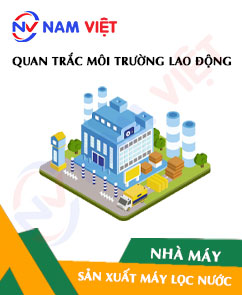
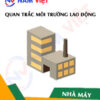
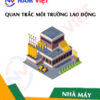
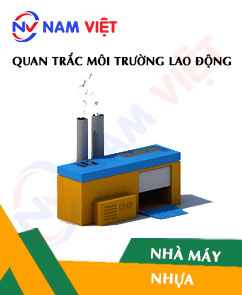

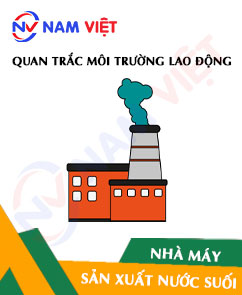
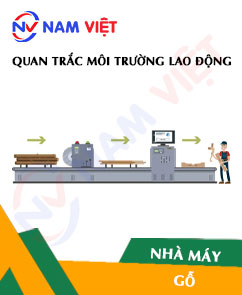
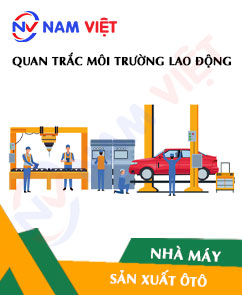
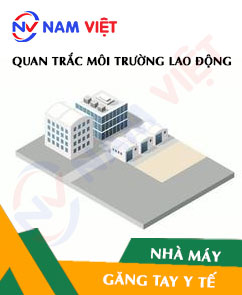


Review Occupational Environment Monitoring at Water Purifier Manufacturing Factory
There are no reviews yet.